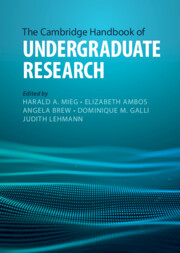Book contents
- The Cambridge Handbook of Undergraduate Research
- The Cambridge Handbook of Undergraduate Research
- Copyright page
- Contents
- Figures
- Tables
- Contributors
- Foreword
- Foreword
- 1 Introduction
- Part I Theory and Research on Undergraduate Research
- Part II Implementation, Approaches, Methods
- Part III Disciplines
- Part IV International Perspective
- 47 Introduction
- Part IV.1 Americas
- Part IV.2 Africa & Middle East
- Part IV.3 Asia & Oceania
- 58 Undergraduate Research in China
- 59 Undergraduate Research in India
- 60 Undergraduate Research in Indonesia
- 61 Undergraduate Research in Japan
- 62 Undergraduate Research in Australia
- 63 Undergraduate Research in New Zealand
- Part IV.4 Europe
- Part V Avenues for Developing Undergraduate Research
- Index
- References
58 - Undergraduate Research in China
Toward Disciplinary Balance
from Part IV.3 - Asia & Oceania
Published online by Cambridge University Press: 11 August 2022
- The Cambridge Handbook of Undergraduate Research
- The Cambridge Handbook of Undergraduate Research
- Copyright page
- Contents
- Figures
- Tables
- Contributors
- Foreword
- Foreword
- 1 Introduction
- Part I Theory and Research on Undergraduate Research
- Part II Implementation, Approaches, Methods
- Part III Disciplines
- Part IV International Perspective
- 47 Introduction
- Part IV.1 Americas
- Part IV.2 Africa & Middle East
- Part IV.3 Asia & Oceania
- 58 Undergraduate Research in China
- 59 Undergraduate Research in India
- 60 Undergraduate Research in Indonesia
- 61 Undergraduate Research in Japan
- 62 Undergraduate Research in Australia
- 63 Undergraduate Research in New Zealand
- Part IV.4 Europe
- Part V Avenues for Developing Undergraduate Research
- Index
- References
Summary
Recently, the Chinese government has advocated a shift in focus from quantity expansion to quality promotion in the field of higher education, with a specific emphasis on enhancing the research competence of higher education institutions. Since 2012, a new state-held “National College Student Innovation and Entrepreneurship Training Program” has pushed undergraduate research (UR) in China to its peak. Tsinghua University, a leading university in science and engineering in the country, is one of the first higher education institutions to promote UR in China and is China’s flagship endeavor. In the future, it is likely there will be a disciplinary balance that maintains the emphasis on science and technology but increases the proportions of humanities and social sciences. Formative assessment is needed for the management and reporting of UR programs. Moreover, further actions must be taken to grant Chinese higher education institutions more autonomy to design UR programs consistent with their own academic strengths.
- Type
- Chapter
- Information
- The Cambridge Handbook of Undergraduate Research , pp. 535 - 542Publisher: Cambridge University PressPrint publication year: 2022



